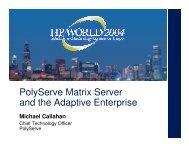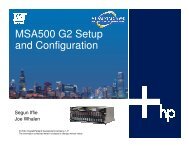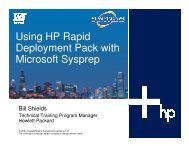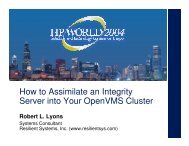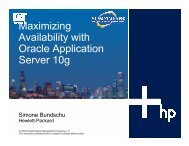HP Integrity Server nPartition Administration - OpenMPE
HP Integrity Server nPartition Administration - OpenMPE
HP Integrity Server nPartition Administration - OpenMPE
Create successful ePaper yourself
Turn your PDF publications into a flip-book with our unique Google optimized e-Paper software.
<strong>HP</strong> <strong>Integrity</strong> <strong>Server</strong><br />
<strong>nPartition</strong><br />
<strong>Administration</strong><br />
Adam E. Schwartz<br />
Information Developer<br />
Hewlett-Packard<br />
© 2004 Hewlett-Packard Development Company, L.P.<br />
The information contained herein is subject to change without notice
Topics covered<br />
• This session will cover the following <strong>nPartition</strong><br />
administration topics:<br />
− <strong>nPartition</strong> overview, servers, OSes, supported<br />
configurations, requirements, recommendations<br />
− Tools, local/remote management, Complex Profiles,<br />
access restriction, commands, Partition Manager<br />
− Configuring <strong>nPartition</strong>s, properties, cell local memory<br />
− OS boot, shutdown, options, autoboot<br />
− Listing status, EFI Shell commands, MP commands<br />
− Related information<br />
• For details, refer to the <strong>HP</strong> System Partitions<br />
Guide at http://www.docs.hp.com/<br />
2
<strong>nPartition</strong> overview<br />
• <strong>nPartition</strong> -- A subset of server (complex)<br />
hardware that is used as an independent system<br />
environment<br />
− Includes: one or more cells (containing processors and<br />
memory) and I/O chassis connected to those cells<br />
− All hardware in an <strong>nPartition</strong> is used exclusively by<br />
software running in the <strong>nPartition</strong><br />
− An <strong>nPartition</strong> has its own system boot interface and<br />
boots and reboots independently<br />
• Hardware and software isolation<br />
− Faults in one <strong>nPartition</strong> do not affect other <strong>nPartition</strong>s<br />
• Reconfigurable using software<br />
− Configure <strong>nPartition</strong>s using <strong>HP</strong> <strong>nPartition</strong> management<br />
tools<br />
3
<strong>Server</strong> hardware overview<br />
• <strong>HP</strong> Superdome SD32A server with eight cells<br />
4
<strong>nPartition</strong>-capable hp <strong>Integrity</strong><br />
servers<br />
• hp <strong>Integrity</strong> servers have Intel® Itanium® 2 processors<br />
− <strong>HP</strong> mx2 dual-processor modules and single Itanium 2 processors<br />
can co-exist in the same complex, but not in the same <strong>nPartition</strong><br />
• hp <strong>Integrity</strong> servers include the following <strong>nPartition</strong>capable<br />
models:<br />
− hp <strong>Integrity</strong> rx7620: 2 cells (8 processor sockets)<br />
− hp <strong>Integrity</strong> rx8620: up to 4 cells (16 sockets)<br />
− hp <strong>Integrity</strong> Superdome: up to 16 cells (64 sockets)<br />
• Operating systems supported:<br />
− <strong>HP</strong>-UX 11i Version 2 (B.11.23)<br />
− Microsoft® Windows® <strong>Server</strong> 2003<br />
− Red Hat Enterprise Linux 3 Update 2<br />
5
Supported <strong>nPartition</strong> configurations<br />
• <strong>HP</strong>-UX 11i Version 2 (B.11.23)<br />
− March 2004 and earlier: up to 64 processors<br />
− September 2004 and later: up to 128 processors<br />
− <strong>HP</strong>-UX B.11.23 supports cell local memory<br />
• Microsoft® Windows® <strong>Server</strong> 2003<br />
− Up to 64 processors<br />
− Windows <strong>Server</strong> 2003 supports cell local memory<br />
• Red Hat Enterprise Linux 3 Update 2<br />
− Up to eight processors; requires single Itanium 2 processors, and<br />
does not support <strong>HP</strong> mx2 dual-processor modules<br />
− Maximum of two cells in an <strong>nPartition</strong>; one PCI-X I/O chassis<br />
− Maximum of 96 GBytes memory<br />
− Does not support cell local memory<br />
6
<strong>HP</strong> <strong>Integrity</strong> <strong>nPartition</strong> requirements<br />
• On <strong>HP</strong> <strong>Integrity</strong> servers, all cells in an <strong>nPartition</strong><br />
must have:<br />
− The same firmware revision<br />
− Either mx2 dual-processor modules or single Itanium 2<br />
processors<br />
− The same compatibility value<br />
• The cell compatibility value is reported by the parstatus -V -c#<br />
command as "CPU Compatibility" for the cell.<br />
• Partition Manager for <strong>HP</strong>-UX B.11.23 reports the value as "Cell<br />
Compatibility" in the General Cell Properties view for the cell,<br />
which you can display by clicking the cell location when viewing<br />
other details about the server complex<br />
• At least one cell in every <strong>nPartition</strong> must be<br />
connected to an I/O chassis that has core I/O<br />
7
Recommended cell assignments<br />
• <strong>HP</strong> recommends and supports <strong>nPartition</strong> configurations that are<br />
tested and that provide good performance<br />
− NOTE: <strong>nPartition</strong> configurations with more than 64 processors are<br />
supported only by the <strong>HP</strong>-UX B.11.23 September 2004 release<br />
8
Online information and tools<br />
• Technical documentation<br />
−<br />
−<br />
http://docs.hp.com<br />
Hardware, <strong>HP</strong>-UX, Linux, Windows, and other documentation<br />
• <strong>HP</strong> Linux Enablement Kit CD<br />
−<br />
−<br />
http://software.hp.com<br />
Select Linux for the CD (ISO image) with tools for storage controller<br />
configuration, disk partitioning, and Linux installation<br />
• <strong>Server</strong> Support and Software<br />
−<br />
−<br />
−<br />
http://www.hp.com/support/itaniumservers<br />
Technical support resources, including documentation and software<br />
For Windows (32-bit) version of <strong>nPartition</strong> commands:<br />
1. Select rx7620, rx8620, or <strong>Integrity</strong> Superdome<br />
2. Select download drivers and software<br />
3. Select Microsoft Windows <strong>Server</strong> 2003 64-bit<br />
4. See the Utility Tools heading for:<br />
− Partition Command Line Interface (ParCLI)<br />
− Graphics interface for the partition management command line utilities<br />
9
<strong>Administration</strong> tools for <strong>nPartition</strong>s<br />
• Management processor (MP)<br />
− Complex-wide service interface<br />
− Access to all hardware and <strong>nPartition</strong>s in the complex<br />
− Command menu, <strong>nPartition</strong> consoles, <strong>nPartition</strong> Virtual Front<br />
Panels, <strong>nPartition</strong> Console Logs, and Event Log<br />
• EFI Boot Manager and EFI Shell commands<br />
− System boot interface for an <strong>HP</strong> <strong>Integrity</strong> <strong>nPartition</strong><br />
− Accessible from the <strong>nPartition</strong> console when <strong>nPartition</strong> has not<br />
booted an OS<br />
• <strong>nPartition</strong> Commands<br />
− For <strong>HP</strong>-UX and Windows: parstatus, parcreate, parmodify, others<br />
• Partition Manager (/opt/parmgr/bin/parmgr)<br />
− Only <strong>HP</strong>-UX B.11.23 systems; provides a Web-based interface<br />
10
Complex Profile overview<br />
• Configurable aspects of a complex are<br />
represented in a set of data called the Complex<br />
Profile<br />
• The Complex Profile consists of three parts:<br />
− Stable Complex Configuration Data<br />
• Complex-wide settings, including the complex name, serial<br />
number, the <strong>nPartition</strong> assignment for each cell, cell local<br />
memory values<br />
− Dynamic Complex Configuration Data<br />
• Architecturally reserved data<br />
− Partition Configuration Data<br />
• Individual <strong>nPartition</strong> settings, including the <strong>nPartition</strong> name,<br />
core cell choices, and other <strong>nPartition</strong>-specific details<br />
11
Complex Profile changes<br />
• The MP manages all Complex Profile data<br />
− It keeps all copies of the data coherent using a locking<br />
mechanism<br />
− The master copy of all parts of the Complex Profile<br />
resides on the MP<br />
− Each cell in the complex has a copy of the Stable<br />
Complex Configuration Data and a copy of the Partition<br />
Configuration Data for the <strong>nPartition</strong> to which it is<br />
assigned<br />
• The MP does not “push out” a Complex Profile<br />
change that affects the assignment of an active<br />
cell<br />
− Instead, it waits for the cell to be inactive, as occurs<br />
during a reboot for reconfig or shutdown for reconfig<br />
12
Types of reboot and reset<br />
• Two special types of reboot and reset for managing<br />
<strong>nPartition</strong>s:<br />
− Performing a reboot for reconfig<br />
• Shuts down the OS, resets all assigned cells, performs any<br />
reconfigurations, cells rendezvous, and boots the <strong>nPartition</strong> back to<br />
EFI<br />
• <strong>HP</strong>-UX shutdown -R command, Windows shutdown /r command, or<br />
the Linux shutdown -r time command<br />
− Performing a shutdown for reconfig<br />
• Makes the <strong>nPartition</strong> and all of its cells inactive<br />
• Shuts down the OS (shutdown command), resets all assigned cells,<br />
performs reconfigurations, and keeps all cells at boot-is-blocked (BIB)<br />
• <strong>HP</strong>-UX shutdown -R -H command, Windows shutdown /s command,<br />
or the Linux shutdown -h time command<br />
− On <strong>HP</strong> rx8620 and rx7620 servers you can configure OS shutdown<br />
for reconfig to either power off hardware or keep cells at BIB<br />
• EFI Shell reconfigreset command, MP Command menu RR<br />
13
<strong>nPartition</strong> management methods<br />
• You can perform most <strong>nPartition</strong> management with the<br />
<strong>nPartition</strong> commands and Partition Manager<br />
• Local management involves using <strong>HP</strong>-UX B.11.23<br />
commands or Partition Manager on an <strong>nPartition</strong><br />
− Requires <strong>HP</strong>-UX B.11.23 be booted and WBEM configured<br />
• Remote management involves using either WBEM or the<br />
MP IPMI LAN interface<br />
− Remote administration using IPMI over LAN<br />
• Commands or Partition Manager interact with the MP<br />
• IPMI LAN must be enabled; must specify IPMI password<br />
− Remote administration using WBEM<br />
• Commands or Partition Manager interact with WBEM<br />
• WBEM must be running on an <strong>nPartition</strong> (<strong>HP</strong>-UX B.11.23)<br />
• Must specify a user (privileged/superuser) and password<br />
14
Choosing a management method<br />
• MP always available<br />
• EFI available via <strong>nPartition</strong> console before OS<br />
booted on the <strong>nPartition</strong><br />
• If no OS is running on an <strong>nPartition</strong><br />
− Must use remote management via IPMI LAN<br />
• If Windows or Linux is running on an <strong>nPartition</strong><br />
− Must use remote management via IPMI LAN<br />
• If <strong>HP</strong>-UX B.11.23 is running on an <strong>nPartition</strong><br />
− Can use commands running on the <strong>nPartition</strong><br />
− Can use Partition Manager running on the <strong>nPartition</strong><br />
− Can use remote management via WBEM<br />
− Can use remote management via IPMI LAN<br />
15
Local management of <strong>nPartition</strong>s<br />
• Command or parmgr WBEM /dev/ipmi BT (MP)<br />
16
Remote management via IPMI LAN<br />
• Intelligent Platform Management Interface (IPMI)<br />
is an industry-standard interface for managing<br />
hardware<br />
− Supports value-added capabilities, such as <strong>HP</strong><br />
<strong>nPartition</strong> and complex management<br />
− Supported by the MP<br />
• MP configuration affects IPMI LAN management<br />
− MP customer LAN IP address, subnet mask, gateway<br />
• LC command configures MP customer LAN settings<br />
− IPMI password<br />
• SO command sets the IPMI password for the MP<br />
− IPMI LAN enabled/disabled<br />
• SA command enables/disables MP’s IPMI LAN access<br />
17
Remote management: IPMI over<br />
LAN<br />
• Command or parmgr WBEM IPMI LAN<br />
(MP)<br />
18
Remote management via WBEM<br />
• Web-Based Enterprise Management (WBEM) acts as an<br />
information broker<br />
− A provider offers access to a resource<br />
− Clients send requests to WBEM to get information about and<br />
access to the resource<br />
− Data is sent using the Common Information Model (CIM) data<br />
model standard<br />
• WBEM configuration affects local and remote<br />
management<br />
− <strong>HP</strong>-UX B.11.23 versions of Partition Manager and the <strong>nPartition</strong><br />
commands are WBEM client applications<br />
− <strong>HP</strong>-UX B.11.23 <strong>nPartition</strong> Provider is a WBEM agent<br />
• Windows provides WMI<br />
− WBEM-to-WMI mapper and WMI <strong>nPartition</strong> Provider supported<br />
19
Remote management: WBEM<br />
• Command or parmgr HTTPS WBEM /dev/ipmi BT (MP)<br />
20
Configuring WBEM<br />
• WBEM systems provide secure remote management<br />
using these files as part of the SSL authentication process<br />
− server.pem -- WBEM SSL Certificate file, on the system that is<br />
being managed and contains the local server's PRIVATE KEY and<br />
CERTIFICATE data<br />
• <strong>HP</strong>-UX path: /var/opt/wbem/server.pem<br />
• Windows path: the %PEGASUS_HOME%\cimcerver_current.conf file;<br />
the sslCertificateFilePath entry specifies the SSL Certificate file<br />
location<br />
− client.pem -- WBEM Trust Certificate Store file, on the system from<br />
which WBEM remote management commands are issued<br />
• <strong>HP</strong>-UX path: /var/opt/wbem/client.pem<br />
• Windows path: the %<strong>HP</strong>_SSL_SHARE%\client.pem file<br />
• To remotely manage a server using WBEM:<br />
− The Trust Certificate Store file (client.pem) must contain a copy of<br />
the CERTIFICATE data from the SSL Certificate file (server.pem)<br />
on the remote server<br />
− The CERTIFICATE data includes all text starting with the "-----<br />
BEGIN CERTIFICATE-----" line through the "-----END<br />
CERTIFICATE-----" line<br />
21
Managing WBEM components<br />
• <strong>HP</strong>-UX B.11.23 WBEM (Pegasus CIM server)<br />
− cimprovider –l –s to list WBEM module status;<br />
cimprovider –d –m module to disable a module, and<br />
cimprovider –e –m module to enable a module<br />
− cimserver –s to stop the WBEM server, and<br />
cimserver to start<br />
− cimconfig –l –c to list the current WBEM configuration,<br />
or cimconfig –l –p to list the pending configuration<br />
• enableRemotePrivilegedUserAccess=True — Enables remote<br />
management of the local <strong>nPartition</strong><br />
• enableHttpsConnection=True — Allows HTTPS/SSL access; also<br />
enableHttpConnection=False to prevent insecure access<br />
• To change settings use cimconfig -s... -p and then stop and restart<br />
WBEM<br />
• For Windows WMI/WBEM details, refer to the Windows<br />
documentation Web site<br />
22
<strong>nPartition</strong> Configuration Privilege<br />
• The MP Command menu PARPERM command<br />
configures the <strong>nPartition</strong> Configuration Privilege for a<br />
complex<br />
• In effect, a restricted <strong>nPartition</strong> Configuration Privilege<br />
limits local and remote WBEM administration abilities<br />
• The <strong>nPartition</strong> Configuration Privilege has two settings:<br />
− Unrestricted -- The default setting, which gives the IPMI BT<br />
interface the same capabilities as the IPMI LAN interface<br />
− Restricted -- Restricts use of the IPMI BT interface to these<br />
capabilities:<br />
• Retrieving information about the server: everything normally displayed<br />
by Partition Manager and the parstatus command is still available<br />
• Making changes to the local <strong>nPartition</strong>'s Partition Configuration Data<br />
• Manipulating any of the attention indicators (LEDs)<br />
• Powering on/off cells and I/O chassis that belong to the local <strong>nPartition</strong><br />
• This privilege does not affect the <strong>nPartition</strong> management<br />
tools use of IPMI over LAN<br />
23
<strong>nPartition</strong> commands<br />
− parcreate to create a new <strong>nPartition</strong><br />
− parmodify to modify an existing <strong>nPartition</strong><br />
− parremove to remove an existing <strong>nPartition</strong><br />
− parstatus to display <strong>nPartition</strong> information and hardware details for<br />
a server complex<br />
− parunlock to unlock Complex Profile data<br />
− fruled to blink attention indicators (LEDs) or turn them off<br />
− frupower to display status or turn power on or off for cells and I/O<br />
chassis<br />
− cplxmodify to change the name of a complex<br />
• Remote via WBEM: use the –u –h set of options<br />
-u username:[password] specifies a valid username on the remote<br />
<strong>nPartition</strong> and optionally specifies the password<br />
-h specifies either the hostname or IP address of the remote<br />
<strong>nPartition</strong><br />
• Remote via IPMI LAN: use the –g –h set of options<br />
-g [password] optionally specifies the IPMI password for the MP<br />
-h specifies either the hostname or IP address of the MP<br />
24
<strong>nPartition</strong> command examples<br />
• parstatus –w<br />
− Report the <strong>nPartition</strong> number for the local <strong>nPartition</strong><br />
• parstatus –w –u root: -h 12.34.56.789<br />
− Report the <strong>nPartition</strong> number for IP 12.34.56.789; this<br />
prompts for the root password for the host<br />
• parcreate –c0/4::: -g –h feshd4u.corp.com<br />
− Create a new <strong>nPartition</strong> using cell 0/4 on the complex<br />
whose MP is the host feshd4u.corp.com; this prompts<br />
for the IPMI password<br />
25
Partition Manager<br />
• Partition Manager provides a graphical interface<br />
for managing <strong>nPartition</strong>s and complex hardware<br />
− Start the Partition Manager Tomcat-based Servlet<br />
Engine<br />
/opt/parmgr/bin/parmgr –s start<br />
− Stop Partition Manager<br />
/opt/parmgr/bin/parmgr –s stop<br />
− Restart using the parmgr -s restart command<br />
− Display status using the parmgr -s status command<br />
• Partition Manager access is through the following<br />
secure (https) URL:<br />
https://host.corp.com:50000/parmgr<br />
where host.corp.com is the local hostname and domain<br />
26
Partition Manager remote options<br />
• To change the system access method, select the<br />
Switch Complexes task from the Tools menu<br />
− Remote via WBEM: use the remote <strong>nPartition</strong> option<br />
− Remote via IPMI LAN: use the remote partitionable<br />
complex option<br />
27
Creating the first <strong>nPartition</strong><br />
• Either create a Genesis Partition or use IPMI over<br />
LAN to remotely create the first <strong>nPartition</strong><br />
− A Genesis Partition is created from MP Command<br />
menu<br />
• CC command, G option -- specifies that a one-cell <strong>nPartition</strong> be<br />
created within the server complex<br />
• Any existing <strong>nPartition</strong> configurations are deleted and are<br />
replaced with a single, one-cell <strong>nPartition</strong> (the Genesis<br />
Partition)<br />
• CAUTION: Creating a Genesis Partition clears Complex Profile<br />
details, including iCOD/PPU configuration data<br />
− Using IPMI over LAN to modify the Complex Profile<br />
• Partition Manager <strong>nPartition</strong> --> Create <strong>nPartition</strong> action<br />
• parcreate command, with the –g –h options specified<br />
• The first <strong>nPartition</strong> in a complex is “Partition 0”<br />
28
Creating additional <strong>nPartition</strong>s<br />
• Either use parcreate or Partition Manager from an<br />
<strong>nPartition</strong> running <strong>HP</strong>-UX in the complex, or use the<br />
remote administration feature of those tools<br />
• If creating <strong>nPartition</strong>s using remote administration:<br />
− IPMI over LAN uses the Partition Manager remote partitionable<br />
complex option or the parcreate command –g –h options<br />
− Remote WBEM administration requires <strong>HP</strong>-UX B.11.23 be running<br />
in the complex, so local management might be simpler<br />
• Can manually boot a newly created <strong>nPartition</strong><br />
− Must manually boot if you did not specify to boot (-B option) when<br />
the <strong>nPartition</strong> was created<br />
− Use the BO command from MP Command menu to boot an<br />
<strong>nPartition</strong><br />
29
Adding/removing cells<br />
• Assign (add) cells<br />
− parmodify -p# -a#... command<br />
− Partition Manager <strong>nPartition</strong> --> Modify <strong>nPartition</strong> action<br />
and select the Add/Remove Cells tab<br />
− After adding a cell to an active <strong>nPartition</strong>, must reboot<br />
for reconfig for the cell to be active/rendezvous<br />
• Unassign (remove) cells<br />
− parmodify -p# -d#... command<br />
• Also specify –B option if removing an active cell and want the<br />
<strong>nPartition</strong> to be active after it is reboot for reconfig<br />
− Partition Manager <strong>nPartition</strong> --> Modify <strong>nPartition</strong> action<br />
and select the Add/Remove Cells tab<br />
− After removing an active cell, you must reboot for<br />
reconfig its <strong>nPartition</strong> for the cell to be removed<br />
30
Deleting an <strong>nPartition</strong><br />
• parremove -p# command<br />
− If removing the local <strong>nPartition</strong> or a remote, active<br />
<strong>nPartition</strong>, also specify the force-remove option (-F)<br />
• Partition Manager -- Select the <strong>nPartition</strong> and use<br />
the <strong>nPartition</strong> --> Delete <strong>nPartition</strong> action<br />
• Perform a shutdown for reconfig of the <strong>nPartition</strong><br />
that is being removed<br />
• shutdown -R -H from <strong>HP</strong>-UX<br />
• shutdown /s from Windows<br />
• shutdown -h time from Linux<br />
• reconfigreset from the EFI Shell<br />
• RR from the MP Command menu<br />
31
Setting cell attributes<br />
• Configurable cell attributes include:<br />
− use-on-next-boot value<br />
• All cells assigned to an <strong>nPartition</strong> that have a “y” use-on-next-boot<br />
value are expected to participate in rendezvous and thus be a active<br />
hardware used by the <strong>nPartition</strong>; “n” means cell will be inactive<br />
− cell local memory value<br />
• Amount or percentage of memory that is local to the cell and is not<br />
interleaved across cells; details in slides that follow<br />
• Must reboot the <strong>nPartition</strong> for new attributes to take effect<br />
• parmodify -p# -m#... command to modify cell attributes<br />
• Partition Manager<br />
− <strong>nPartition</strong> --> Modify <strong>nPartition</strong> action<br />
− Use the Set Cell Options tab to set use-on-next-boot<br />
− Use the Configure Memory tab to set the cell local memory value<br />
32
Cell local memory overview<br />
• Memory region that is not interleaved across all<br />
cells in the <strong>nPartition</strong><br />
− Potentially better performance due to lower latency<br />
• Memory configured as cell local memory can only<br />
be used by operating systems that support it<br />
− <strong>HP</strong>-UX B.11.23 and Windows <strong>Server</strong> 2003 support cell<br />
local memory<br />
− Red Hat Enterprise Linux 3 does not support cell local<br />
memory<br />
− CAUTION: Any memory configured as cell local<br />
memory is unusable when an <strong>nPartition</strong> runs an<br />
operating system that does not support it<br />
33
Cell local memory guidelines<br />
• Configure cell local memory only for <strong>nPartition</strong>s<br />
booting <strong>HP</strong>-UX B.11.23 or Windows <strong>Server</strong> 2003<br />
• For best performance, <strong>HP</strong> recommends the<br />
amount of interleaved memory meet these<br />
guidelines:<br />
− The number of cells participating in memory interleave<br />
should be a power of two<br />
− Each cell participating in interleave should contribute<br />
the same amount of memory<br />
− The total amount of memory being interleaved should<br />
be a power of two number of GBytes<br />
• All memory not specified as being cell local will<br />
be interleaved<br />
34
Cell local memory specification<br />
• You can specify the cell local memory value in either of<br />
two forms: percentage or absolute amount of memory<br />
• Percentage cell local memory<br />
− This number is rounded to 12.5%, 25%, 37.5%, 50%, 62.5%, 75%,<br />
87.5%, or 100% (nearest eighth) for cells with >=4 GBytes<br />
− If the cell contains less than 4 GBytes of memory, then the<br />
percentage is rounded to 25%, 50%, 75%, or 100%<br />
− Percentages are rounded up or down to the nearest value, but are<br />
not rounded up to 100%<br />
• Absolute cell local memory<br />
− The absolute number is interpreted as the absolute number of<br />
gigabytes and is rounded up to the nearest 0.5 GBytes<br />
35
<strong>HP</strong> <strong>Integrity</strong> server OS boot process<br />
• <strong>HP</strong> <strong>Integrity</strong> <strong>nPartition</strong> boot environment is the Extensible Firmware<br />
Interface (EFI): EFI Boot Manager menu and the EFI Shell<br />
• EFI provides a boot options list: paths to bootable files<br />
36
Boot process for cells and<br />
<strong>nPartition</strong>s<br />
• <strong>nPartition</strong> boot process includes two phases: the cell boot<br />
phase and the <strong>nPartition</strong> boot phase<br />
• Cell boot phase: Occurs when cells are powered on or<br />
reset; involves power-on-self-test activities<br />
1) Cell is powered on or reset, and the cell boot-is-blocked (BIB) flag is<br />
set<br />
2) Firmware on the cell performs self-tests and discovery operations<br />
3) Cell reports the cell hardware configuration to the MP and informs MP<br />
it is "waiting at BIB“; waits for BIB flag to be cleared<br />
• <strong>nPartition</strong> boot phase: Occurs after a quorum of cells<br />
complete self tests; “<strong>nPartition</strong> rendezvous” occurs<br />
1) MP provides a copy of relevant Complex Profile data to the cells<br />
2) MP releases BIB for all cells assigned to the <strong>nPartition</strong> with a "y" useon-next-boot<br />
value and complete the cell boot phase in time (10<br />
minutes)<br />
3) <strong>nPartition</strong> rendezvous begins: each active cell uses its copy of<br />
Complex Profile data to contact other active cells<br />
4) Active cells negotiate to select a core cell<br />
5) The chosen core cell manages the rest of the <strong>nPartition</strong> boot process<br />
− A processor on the core cell runs the EFI boot environment<br />
37
<strong>nPartition</strong> boot configuration<br />
• Autoboot is configured by the EFI autoboot setting and<br />
the order of items in the boot options list<br />
• EFI Boot Manager: Boot option maintenance menu --> Set Auto Boot TimeOut<br />
• EFI Shell: autoboot command<br />
• <strong>HP</strong>-UX: setboot -b on or setboot -b off command<br />
− When autoboot is enabled, EFI attempts to automatically load/boot<br />
after rendezvous, starting with the first item in the boot options list<br />
• <strong>nPartition</strong> ACPI configuration setting must be set properly<br />
for the OS being booted<br />
− Use the EFI Shell acpiconfig command; details on the following<br />
slide<br />
• Boot-time system tests (self tests) are configured by EFI<br />
Shell boottest command or <strong>HP</strong>-UX setboot command<br />
• Boot options list is configurable<br />
• EFI Boot Manager: Boot option maintenance menu<br />
• EFI Shell: bcfg boot command to set; variable command to<br />
save/restore<br />
• <strong>HP</strong>-UX: /usr/sbin/setboot or /usr/sbin/parmodify command<br />
38
ACPI configuration value<br />
• Each <strong>nPartition</strong> requires the proper ACPI<br />
configuration for the OS to be booted<br />
− To check the ACPI configuration value, issue the<br />
acpiconfig command with no arguments at the EFI<br />
Shell<br />
− To set the ACPI configuration value, issue the following<br />
EFI Shell command: acpiconfig value<br />
• value is either default, windows, or single-pci-domain<br />
− <strong>HP</strong>-UX ACPI value: default<br />
− Windows ACPI value: windows<br />
− Red Hat Enterprise Linux 3 ACPI value: single-pci-domain<br />
• Reset (reset EFI Shell command) for the setting to take effect<br />
• NOTE: When configuring <strong>HP</strong>-UX or Linux boot options, the ACPI<br />
value must be set as above for device paths to be properly<br />
established<br />
− For Windows boot options use MSUtil\nvrboot.efi to import the<br />
EFI\Microsoft\WINNT50\Boot00... file<br />
39
Active and inactive cells<br />
• A cell that is assigned to an <strong>nPartition</strong>, has<br />
booted, and has participated in <strong>nPartition</strong><br />
rendezvous is an active cell<br />
− For cell resources to be used, the cell must be active<br />
• An inactive cell either is not assigned to an<br />
<strong>nPartition</strong>, or if assigned did not rendezvous<br />
− For example: a cell is inactive when powered off,<br />
booted with a “n” use-on-next-boot value, or assigned<br />
to an <strong>nPartition</strong> that is in the shutdown for reconfig<br />
state<br />
− Resources belonging to inactive cells are not used<br />
40
ACPI "Softpowerdown“: rx7620 and<br />
rx8620 shutdown for reconfig<br />
• You can configure the <strong>nPartition</strong> behavior when an OS is<br />
shutdown and halted on rx7620 and rx8620 servers<br />
• The normal OS shutdown behavior depends on the ACPI<br />
configuration; the options are:<br />
− <strong>nPartition</strong> hardware power off<br />
• This is the normal behavior for the “windows” ACPI setting<br />
• If only one <strong>nPartition</strong> is defined then powers off the server cabinet<br />
(including all cells and I/O chassis) else powers off assigned hardware<br />
• Can manually set from EFI shell using:<br />
acpiconfig enable softpowerdown<br />
− <strong>nPartition</strong> remains inactive (all cells at BIB)<br />
• This is the normal behavior for the “default” and “single-pci-domain”<br />
ACPI settings<br />
• Can manually set from EFI shell using:<br />
acpiconfig disable softpowerdown<br />
41
Booting an OS<br />
• You can boot an OS either by selecting its entry<br />
from the EFI Boot Manager (boot options list) or<br />
by invoking the OS loader from the EFI Shell<br />
− <strong>HP</strong>-UX B.11.23 OS loader is <strong>HP</strong>UX.EFI<br />
• You can issue hpux(1M) loader commands at the <strong>HP</strong>UX><br />
prompt<br />
− Windows loader is ia64ldr.efi and it is invoked only from<br />
the EFI Boot Manager<br />
• Special <strong>Administration</strong> Console (SAC) interface is available via<br />
the console after an <strong>nPartition</strong> has loaded Windows<br />
• Use the SAC> command prompt; issue the ? or help command<br />
− Red Hat Enterprise Linux loader is ELILO.EFI<br />
• You can issue ELILO commands at the "ELILO boot" prompt<br />
• CAUTION: An <strong>nPartition</strong> must have its ACPI configuration value<br />
properly set to boot an OS<br />
42
Invoking OS loader from EFI Shell<br />
• Can directly load <strong>HP</strong>-UX and Red Hat Linux<br />
1) Access the EFI Shell<br />
2) Use the map EFI Shell command to list the EFI System Partitions<br />
(filesystems) available, and as needed use the search command to<br />
search for filesystems on non-core cells<br />
3) Access the EFI System Partition (for example fs0:) for the root<br />
device and then invoke the loader<br />
• Enter <strong>HP</strong>UX to invoke the <strong>HP</strong>-UX loader (<strong>HP</strong>UX.EFI)<br />
− The full path is \EFI\<strong>HP</strong>UX\<strong>HP</strong>UX.EFI<br />
− When invoked, <strong>HP</strong>UX.EFI references \EFI\<strong>HP</strong>UX\AUTO and boots<br />
<strong>HP</strong>-UX using the default boot behavior specified in the AUTO file<br />
• Enter \EFI\redhat\elilo.efi to invoke the Linux loader (ELILO.EFI)<br />
− The \efi\redhat\elilo.conf file defines the kernel boot configurations<br />
available to be selected<br />
4) As needed, interact with the OS loader<br />
• Windows is loaded from EFI Boot Manager only<br />
43
OS Shutdown<br />
• <strong>HP</strong>-UX has these commands for shutting down:<br />
− shutdown -R shuts down <strong>HP</strong>-UX and performs a reboot for reconfig<br />
− shutdown -R -H shuts down <strong>HP</strong>-UX and performs a shutdown for reconfig<br />
− shutdown -r same effect as shutdown -R on <strong>HP</strong> <strong>Integrity</strong> servers<br />
− shutdown -h same effect as shutdown -R -H on <strong>HP</strong> <strong>Integrity</strong> servers<br />
• Windows has these commands for shutting down:<br />
− shutdown /r shuts down Windows and performs a reboot for reconfig<br />
• Equivalent to: StartShut Down, Restart<br />
− shutdown /s shuts down Windows and performs a shutdown for reconfig<br />
• Equivalent to: StartShut Down, Shut down<br />
− Refer to the help shutdown Windows command for details<br />
− From GUI select Shut Down from the Start menu and choose Restart or Shut down<br />
− CAUTION: Issuing restart or shutdown at the SAC> prompt causes the system to restart or<br />
shutdown immediately and can result in the loss of data<br />
• Red Hat Enterprise Linux 3 has these commands for shutting down:<br />
− shutdown -r time shuts down Linux and performs a reboot for reconfig<br />
− shutdown -h time shuts down Linux and performs a shutdown for reconfig<br />
− time is required and can be specified as follows:<br />
• Absolute time in the format hh:mm, in which hh is the hour (one or two digits)<br />
and mm is the minute of the hour (two digits)<br />
• Number of minutes to wait in the format +m, in which m is the number of<br />
minutes<br />
• now to immediately shut down; equivalent to using +0 to wait zero minutes<br />
44
Listing system status<br />
• Commands for status<br />
− parstatus -C command -- Cell configurations<br />
− parstatus -V -c# command -- Detailed cell information<br />
− parstatus -B command -- <strong>Server</strong> cabinet summaries<br />
− parstatus -V -b# command -- Detailed cabinet status<br />
− parstatus -X command – Complex and product details<br />
− parstatus -P command – Summaries of all <strong>nPartition</strong>s<br />
− parstatus -V -p# command -- Detailed <strong>nPartition</strong> info<br />
• Partition Manager features for status<br />
− General tab, Hardware tab, <strong>nPartition</strong>s tab, Cells tab,<br />
I/O tab, CPUs/Memory tab, Power and Cooling tab, and<br />
the Complex --> Show Complex Details action<br />
45
EFI Shell commands for <strong>nPartition</strong>s<br />
• These EFI Shell commands are provided for <strong>nPartition</strong>capable<br />
<strong>HP</strong> <strong>Integrity</strong> servers<br />
See the help command for details<br />
− autoboot — Enables and disables automatic boot, and sets the<br />
boot delay (timeout)<br />
− bcfg — Displays and modifies the boot options list<br />
− lanboot — Boots over LAN; also use the lanboot select command<br />
to choose which LAN/MAC<br />
− reset, reconfigreset — Normal reset, or perform a reset to a<br />
“shutdown for reconfig” state<br />
− acpiconfig — Sets the ACPI mode: “default” for <strong>HP</strong>-UX B.11.23,<br />
“single-pci-domain” for Red Hat Linux, “windows” for Windows<br />
− cellconfig, cpuconfig, dimmconfig — Configures or deconfigures<br />
cells, processors, memory<br />
− rootcell — Sets and views core cell choices<br />
− info — Displays hardware information (for example: info sys, info<br />
cell, info boot, and more)<br />
46
MP commands for <strong>nPartition</strong>s<br />
• These commands are available from the MP Command<br />
menu of <strong>nPartition</strong>-capable <strong>HP</strong> <strong>Integrity</strong> servers<br />
− BO — Boots an <strong>nPartition</strong> past the boot-is-blocked (BIB)<br />
“shutdown for reconfig” state (make it active)<br />
− CP — Displays the <strong>nPartition</strong> cell assignments<br />
− PARPERM — Restricts or unrestrict the <strong>nPartition</strong> Configuration<br />
Privilege<br />
− LC — Sets the MP LAN configuration<br />
− PD — Sets the default <strong>nPartition</strong> for the current login session<br />
− RS — Resets an <strong>nPartition</strong><br />
− RR — Resets an <strong>nPartition</strong> to the “shutdown for reconfig” state<br />
(make it inactive)<br />
− SA — Sets network access parameters (including IPMI LAN<br />
access)<br />
− SO — Configures security and access control options (including<br />
the IPMI password)<br />
• Enter HE (the help command) for details<br />
47
Summary<br />
• <strong>HP</strong> <strong>Integrity</strong> supports multiple OSes:<br />
<strong>HP</strong>-UX B.11.23, Windows, Linux<br />
• Remote management:<br />
WBEM or IPMI LAN<br />
• Special types of <strong>nPartition</strong> reboot:<br />
“reboot for reconfig” and “shutdown for reconfig”<br />
• ACPI configuration:<br />
default, windows, single-pci-domain<br />
• ACPI “Softpowerdown” option:<br />
OS shutdown behavior for rx7620 and rx8620 servers<br />
• Cell local memory:<br />
Guidelines; <strong>HP</strong>-UX B.11.23 and Windows support CLM<br />
48
Related information<br />
• Send your feedback to: adam.schwartz@hp.com<br />
• For details, refer to the <strong>HP</strong> technical documentation Web site:<br />
http://www.docs.hp.com/index.html<br />
• See the <strong>HP</strong> System Partitions Guide: <strong>Administration</strong> for <strong>nPartition</strong>s<br />
book for complete details on managing <strong>nPartition</strong>s on <strong>HP</strong> <strong>Integrity</strong><br />
servers and <strong>HP</strong> 9000 servers<br />
• For Windows tools and documentation, also see the<br />
http://www.hp.com/support/itaniumservers Web site<br />
• For WBEM details, see the <strong>HP</strong> WBEM Services for <strong>HP</strong>-UX and Linux<br />
System Administrator’s Guide at the docs.hp.com Web site<br />
49
Co-produced by:





